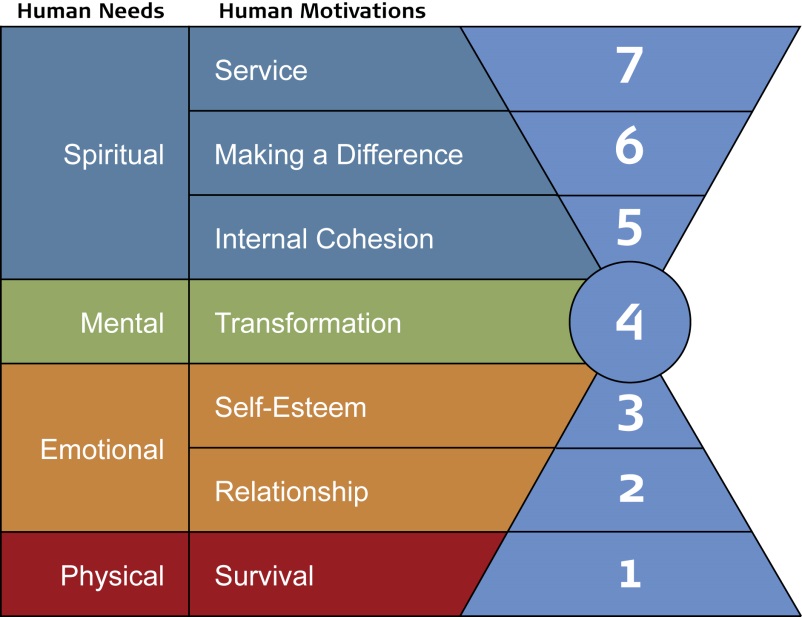Using Values-Based Leadership to Drive Performance
This is one of our free-to-access content pieces. To gain access to all Ideas for Leaders content please Log In Here or if you are not already a Subscriber then Subscribe Here.

Values-based leadership can drive the performance of organizations, and managing those values is the key to unlocking increased performance. Richard Barrett’s model maps values for individuals, groups, organizations and nations. It can identify the gaps between observed and desired values and the negative values that create dysfunction, and can be used to show where change needs to occur to create higher performance.
Richard Barrett’s Seven Levels of Consciousness model, founded on the principles of values-based leadership, is a guide to achieving exceptional performance in organizations. Barrett’s framework based on his extensive research across organizations and increasingly whole countries is an extension of Maslow’s Hierarchy of Needs.
Maslow’s Hierarchy of Needs is a well-explored, but frequently misrepresented, theory on human motivation. Although Maslow did not originate the hierarchy as a pyramid that is how it has come to be depicted. However, the pyramid structure is misleading in that higher levels can be achieved while lower levels are incomplete, and elements of all levels are interconnected. It is not like a video game where simple progression to the next level is achieved when the previous level is completed.
The model has been expanded since with additional levels:
Richard Barrett has developed his Seven Levels of Consciousness model so that each of his levels relate to Maslow’s levels as below, though Barrett had adapted Maslow’s levels a little. Maslow’s 1 and 2 are combined into Barrett’s ‘physical’; 4a and 4b above become ‘transformational’; and 5 and 6 are divided into ‘internal cohesion’, ‘making a difference’ and ‘service’.
The critical change is the move from need to consciousness – Barrett’s contention is that where an individual still has a need, though it is unconscious, they are limited from progressing to a higher state of motivation.
“It was evident to me that when people have underlying anxieties or subconscious fears about one of their lower order deficiency needs, their subconscious remains focused on that need…. For example, there are people who are never satisfied with the amount of money they earn. Even though they may be very rich, for them, that need remains unfulfilled. No matter how much they earn, they are always left wanting more. Such people remain subconsciously focused at the Survival level of consciousness even though they may have mastered several of the other higher levels of consciousness.”

Barrett had developed the model alongside his Cultural Transformation Tools (CTT) for a variety of different scenarios, at the most general, the seven levels can be applied individually and also to organizations. So where an individual’s base Survival need may be for food, shelter, stability etc., for an organization it would be Financial Stability, including shareholder value, cashflow, profits etc.
The model is predicated on the concept that high performing organizations need to align their actual and desired values. Organizations that have dissonance between their actual and desired (or perceived) values cannot operate at the highest levels, nor can those with high levels of negative values or ‘cultural entropy’.
To measure the presence of the values, both positive and negative, individuals within an organization are asked to select from a list of around 80 prescribed terms:
These are then mapped and aggregated. Each value term selected has a place on the egg-timer framework, ‘honesty’ for instance is a ‘positive’ Level 5 value; ‘hierarchical’ is a ‘negative’ Level 3 value. Negative values are ones that are limiting to growth and performance.
The aggregated total of all the values gives the organization (or individual or nation) their ‘cultural entropy’ score. Between 0-10% is healthy; 11-20% indicates minor issues; above 20% significant issues; over 40% indicates in crisis.
Barrett’s research shows a high inverse correlation between entropy scores and employee engagement. (High entropy = low engagement). It also shows a high correlation between leaders’ scores and those of the organization.
Organizations that can lower their leaders’ entropy scores see simultaneous improvement in organizational performance.
Barrett’s Seven Levels of Consciousness Model. Barrett Values Centre (2009).
Liberating the Corporate Soul. Richard Barrett. Butterworth-Heinemann (1998).

Ideas for Leaders is a free-to-access site. If you enjoy our content and find it valuable, please consider subscribing to our Developing Leaders Quarterly publication, this presents academic, business and consultant perspectives on leadership issues in a beautifully produced, small volume delivered to your desk four times a year.

For the less than the price of a coffee a week you can read over 650 summaries of research that cost universities over $1 billion to produce.
Use our Ideas to:
Speak to us on how else you can leverage this content to benefit your organization. info@ideasforleaders.com